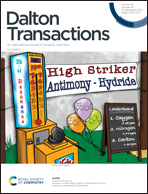Bis-cyclometallated Ir(iii) complexes containing 2-(1H-pyrazol-3-yl)pyridine ligands; influence of substituents and cyclometallating ligands on response to changes in pH†
Abstract
Bis-cyclometallated Ir(III) complexes containing 2-(1H-pyrazol-3-yl)pyridine ligands have been synthesised. Their absorption is almost unchanged with changes in pH however the emission intensities vary by a factor of up to three and the complexes have emission pKas in the range 8.0 to 10.0. Substituents on the pyrazole have only a minor effect on the emission pKa. Surprisingly the complexes with phenylpyrazole cyclometallated ligands 3aL1–3 showed an intensity decrease with increasing pH (switch off) whilst the corresponding phenylpyridine ones 3cL1–3 showed an increase in emission intensity with increasing pH. Putting electron-withdrawing CF3 substituents on the cyclometallating phenyls reduced the pKa of the complexes to 6.8–7.8, thereby extending the useful pKa range; however, in general it tended to reduce the magnitude of the change in emission intensity. Surprisingly the CF3-substituted complexes also showed a complete reversal in the direction of the intensity change when compared to their respective unsubstituted congeners.



 Please wait while we load your content...
Please wait while we load your content...